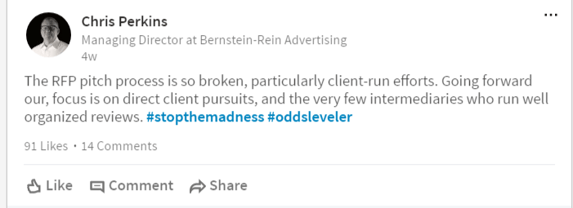
A little over a month ago, I saw this post in my LinkedIn feed:

It inspired a lot of discussion as the frustrations around RFPs and pitching resonate with many agency owners, for reasons we recently covered here. I reached out to the poster, Chris Perkins, who is the Managing Director at Bernstein-Rein Advertising in Kansas City, MO, and he generously agreed to speak with me about why he posted this, what prompted the change, and how it is working out for them at Bernstein-Rein.
At the risk of dropping a spoiler, Bernstein-Rein knows what they are doing when it comes to new business. Chris offered up many insights that would be useful to other agencies aspiring to stop wasting resources on RFPs they will never win. If your agency is looking for a viable path to sidestep the broken RFP / pitch process, or if you are interested in learning about a well-developed agency new business program, this is worth a read.
Here is the transcript from our call:
Mark: It’s always good to see that an agency is taking responsibility for their own destiny. So I wanted to talk to you about your post—you’re not thumbing your nose at the RFP, right? You’re just shifting your thinking...?
Chris: Well, we’ve established kind of a checklist of what equates to a reasonably well-run process. And we’re aggressively trying to minimize the need to even go through a “group grope” of the RFP—because that isn’t how we work in reality, and it very rarely results in stuff that gets produced. So it’s an extremely expensive waste. Part of what we try really hard to do is make sure that there’s adequate access to clients and to the decision-makers, so that we can get an understanding of cultural fit, the way they come at solving business problems with marketing, and the degree to which they’re looking for a partner versus a vendor.
I think a lot of us agencies, in times of wanting to add revenue, have lied to ourselves that “we can win ‘em over,” that we can cut away through the fog of indifference and lack of clarity and unstructured budgets, or budgets that don’t exist, that kind of stuff. Obviously, we will have incoming RFPs, and we want to facilitate those happening—but we also want to be better, smarter, more agile, and thoughtful, frankly, both for our benefit and prospects’ in saying “no” when it’s the wrong fit.
My goal is to have less than 20% of our pursuits come from RFPs, period. And that means we’ve got the pressure of making 80% of our pipeline come from a very thoughtful outreach program, and we can be the catalyst for getting them to go from indifference to thinking “there is a difference.”
“...a lot of us agencies, in times of wanting to add revenue, have lied to ourselves that ‘we can win ‘em over’...”
Mark: Right. So it sounds like you have created filters, which we always suggest; it could be a list of five or ten questions, and if four of the five aren’t yeses, then you don’t pitch it. Have you established that type of setup where you’ve created those questions? And do you have a committee of people who make a collective decision, or is it you and then you share it with your team?
Chris: We have a checklist that we evaluate. My VP of business development and I get together and complete a draft, and then we have a sit down with the executive team and present our recommendation. The good news is that unless we’re on the bubble, it’s really not anything more than me sharing information, that’s the beauty of the thing—as a director, I get to decide. And that is important because a number of times I’ve been in situations where the lack of clarity around who gets to decide gets in the way of clarity over what you should do. And you can’t make these decisions by committee. You can build consensus, you can get alternate perspectives, but in the end, there needs to be somebody who is the decision-maker.
Ideally, you'll have a process or an approach that’s clear enough and meaningful enough that it’s not going to be, “Yeah, but let’s still do it,” because that’s kind of lame. So we’ve got about ten or eleven questions; none of them would surprise you: cultural fit, is there a revenue option, is there an opportunity here, can we make money? Can we make fame? Do we know someone there, do they know us, why did they call us, those kind of things.
Mark: All good questions to ask. I think sometimes we do ourselves a disservice when we say, “These are just the simple questions, the obvious ones. Everybody’s doing that,” but you’d be surprised, very few are actually doing that. Because it goes back to what you said earlier—when there’s nothing in the pipeline, you get these calls, you get these RFPs, and then you start telling yourself, “Well, yeah, you know what, I think we can do this. We have no experience in this industry, but we know we really could.” And it’s something that we talk about in our sales training; we start with that “hope-ium.” And it’s like in the movie Dumb and Dumber, “So you’re telling me I’ve got a chance?”
Chris: Exactly. Exactly. I want to believe so badly that I’ll deny myself into stupidity.
Mark: Well, that’s great that you have a disciplined process—which many agencies are sorely lacking when it comes to new business—so I tip my hat to you guys. So now you’re going to take the 80-20 rule, and hopefully, 80% of your new business is going to come through proactive engagement. What does that look like? Are you creating content for lead nurturing purposes or is your VP of business development going to now turn into an outbound sales pro rather than responding to RFP's, pitch coordination, etc.? How does that switch happen?
Chris: It’s not as big a switch as you would imagine it would be (given the LinkedIn post).
Mark: Right. Because you were already doing best practices; outreach, outbound best practices.
Chris: Exactly. I would say what lead me to do that was a situation where we deviated from our qualification system. One of our criteria is that the client is serious about considering you and that they have good reasons to, and they’ve made that known, and you have some visibility so that it’s not that you’re just another agency in town. And we’d lied to ourselves about that one because we wanted it, and we thought, “We can win them over,” and then we didn’t do the right things to do that.
You can always look back on any pitch and improve. And unfortunately, we had a range of things we could’ve done a whole lot better. In part, because people had vacations and there were other things that were keeping us from doing our best, which is again one of those things in our criteria list. It says, “If you can’t do your best, don’t do it.” Well, when you get into that swirl of "Boy, it sure would be nice if we did it," you’re making a mistake, and I think it’s hard to stay true to your qualification system.
“...when you get into that swirl of ‘Boy, it sure would be nice if we did it,’ you’re making a mistake…”
To your question, we do have thoughtful outreach; we do what we do for our clients, and for ourselves. Our head of business development is an account director in essence. She understands that she has to run it like a PnL for our agency, as the agency brand. And so she has not only prospect acquisition and frontal management, but she has—with my pretty strong involvement—our agency brand and the way we look in the marketplace as part of her responsibility. Because to me, those are inextricably linked and trying to divide that up just isn't logical unless you just have two people that work really, really well together.
So we’re very thoughtful about it—we split the market into eleven verticals, and we’ve got tons of sub-verticals within each of those because that’s how it maps. We’re very methodical about going into a segment and determining the highest propensity prospects, having some rationality to that and figuring out what business problem we’re going to approach them with a proposed solution to, with marketing around it and surrounding it, and hold up a couple of examples as proof to try and skip the line and just have them go, “God, you know what? I do need that. Absolutely. That’s a no-brainer.”
“This is not a ‘spray and pray’ type of process; it sounds like a very disciplined process…”
Mark: So you’re doing a lot of the market research and a lot of the upfront work before engaging with a prospective client. This is not a “spray and pray” type of process; it sounds like a very disciplined process that you’re employing (versus “We’re just not answering RFPs anymore. Instead, we’re going to make phone calls”). And it also sounds like you have some history doing that. This doesn’t sound like a seismic shift from RFP to outbound, or RFP into direct engagement. It’s more of a subtle strategy shift.
Chris: Yeah. It’s something that I learned probably ten years ago in earnest and have either done or managed the doing of since then—and it works. I’m a year and a half in here at Bernstein-Rein. We have the good fortune of having a pretty solid pipeline, and we’re finally getting our team together, to be able to convert with more regularity. And so now, we’ve really got and are building a lot of the infrastructure to support it in much more refined ways.
We’re working on a revised website, we’re looking at a content area. We’ve got a social program, we’ve got a paid PR person, we’ve got our event strategy, we’ve got all those things that triangulate around getting that moment with somebody where you can actually have that elevator pitch conversation where they go, “Christ, you’re right.” And we do email marketing, we do social, paid social, we’re doing search, all those kinds of things.
Mark: So how large of an agency are you? How many full-time employees?
Chris: A hundred and twenty-five.
Mark: Okay, 125. Well, that sounds like you've got a great program. Now, in the sense of conversion, have you found that your conversion rate is increasing as you’re getting smarter about new business? I’m not suggesting that’s all you guys ever did was respond to RFP’s, but as you become more strategic and more disciplined in who you go after, do you find that that the percentage is increasing?
“I want to be a little expensive but with the commitment that there is a reason why, and we’re prepared to prove it…”
Chris: So I would say this: when I got here, the place was fairly focused on trying to get projects to grow into something more. And I have not walked away from projects, but what I have definitely walked away from are loss leaders or being inexpensive or being a value, or a cost-based value play. I want to be a little expensive but with the commitment that there is a reason why, and we’re prepared to prove it to you. And that’s true whether it’s a project or a retained relationship or a mix of the two. So the combination of our organic growth and the new account growth.
We’ve added probably 28% growth on an 18 or 19-month window. And I’d like to see 20% growth year to year; I think we can onboard that in a reasonable way and also be very strategic about it so we’re not becoming a retail shop or becoming a vertical shop that’s so tied to one or two verticals or industries that are ultimately affected by trends and the kind of market forces that caused the ebb and flow on those verticals.
Mark: Well, that’s a nice growth percentage. I’m sure many agencies would be salivating at that. One thing that came to mind when you were talking about your process is that you’re coming from a position of strength. I’m sure you’re playing within the verticals in which you can demonstrate industry expertise; obviously, you’ve done your homework. So when you do engage with that prospective client, you’re going in there on an equal playing field.
Many agencies act or react out of desperation; they are so grateful that a prospective client will meet with them, they’re just willing to do anything. It’s about creating equal business stature. You belong in the room. And when you’re approaching it the way that you’re approaching it, you do belong in the room. You deserve to be in the room, and you might be able to get a little bit more—charge a little bit more because of that.
“Many agencies act or react out of desperation…”

One other point I wanted to make is, we’re in a project-based environment. I think a lot of clients out there are looking to date before they get married.
I think the project-based environment is good for smaller and medium-sized agencies like yourself because the bigger agencies might not be able to, from a cost standpoint, be able to justify going after it. Also, with project work, there’s the staffing issue. Will you need to bring on people to work on this project? I wish there were more project opportunities out there, but there is business out there. Everything is hard fought, though; there are no easy wins.
Chris: And that’s true of existing clients, keeping them happy, and it's a constant battle in running an agency these days—every one of us is fighting the cost creep, insurance, salaries, and the decline of the value of hours in the agency business, which has created this stupid fee-to-hour model that is just completely illogical and irresponsible on many levels.
And so we've also got more nontraditional comp—we're meeting with a company where we're talking about a graduated fee with a fixed amount held in escrow, plus a sales performance incentive, plus an equity advance kicker. And they're just like, well, why can't you just do it on an hourly rate? And we’re telling them, “Here's how this is valuable to you. You're not paying out of your pocket; you're paying out of your performance.” It’s like, “Oh...Oh! Okay.”
But I think most agencies suck at having those conversations because they're just happy to get a hundred and twenty dollars an hour at a blended hourly rate, and frankly I almost don’t want that. I want a hundred and fifty with a chance of getting a hundred extra per hour on an average basis because that’s the kind of business difference we want to make for a company. If they're really seriously going to take what we can do for them and use it. I'm not talking about spending more money either; I'm talking about spending the same or less. But it's a hard conversation because the agencies have talked themselves into this corner of being a vendor and particularly in the project space, you know, it's, “I have $200,000, can you do it or not?” No, I can't.
I love it when RFP's ask how you like to be paid. Because how does someone win at that question? Ultimately, we make every effort to have our compensation be relative to the impact our ideas are intended to make for our client’s business.
“...agencies have talked themselves into this corner of being a vendor…”

Mark: Getting back to your strategic shift—taking a more proactive approach to your success. What's your sense of how long this is going to take? You’ve got some great work in CPG, in QSR, and some other industries as well. How much runway are you giving yourself to land a piece of business, is it a certain amount of months, a year, two years?
Chris: I'll answer that in a couple of ways. One, the plan is to bring in one mid-size account with the hope of maybe one large one, but really one well-conceived relationship every six months. Any more than that, it starts to get untenable. And when I say that, I'm talking about a three to five million revenue account that we can onboard and get right and staff for and not have the entire place collapse. And frankly, we are purposely working a range of categories because we don’t want to be a specialty shop. What we are great at, what our specialty is, is helping businesses grow through marketing.
When I got here, there was a desire to become a retail shop and try to compete in that space. My first comment to the team when they said that was, “I don't know if you guys have looked at the performance of those companies, but which of those companies that are going to close do you want to get screwed by?” I don’t want to be holding that bag. I mean, just look around. And there are some retail brands that we are approaching, but frankly, it's really about helping them revise what they're doing as a business model. Specifically, we’re focused on helping clients take a holistic customer experience view, with a major push toward helping them understand the experience roles today around “brick and mortar” vs. “click and mortar.” Because the problem for many of them is not marketing. Advertising won't solve their problems. It will only begin to help address it.
Mark: I think agencies have done themselves a disservice because they’ve left that door open, and that’s why you’ve got Accenture and other consultancies coming in. Agencies are creating marketing and advertising, but they haven’t really provided business solutions. We tell our agency partners —a prospect wants to know, have you worked in my industry, what problems have you solved, what solutions have you provided. It really boils down to that. It's not about your pithy marketing speak on your website; there's so much of that out there. There's just this sea of sameness, no differentiator between one from the next.
“Do you like red spots, I got red spots. Do you like blue?”

Chris: I would say two-thirds of agencies are chameleon-like in that their approach is basically, “Do you like red spots, I got red spots. Do you like blue? Oh, you really want green. Oh, we're definitely green.” I mean, come on. We come at it very directly, and we tell them what we're not as much as we tell them what we are. The clarity of that—it's a stopping point, but it's also a starting point— and frankly, if you get them past that point and aren’t the agency that says, “Oh, yes, we're great, we can do everything.” Which is complete bulls—. If you can get past that point, you might forge a meaningful partnership. I mean, I worked at Ogilvy which is 60,000 people globally, and you can't do everything there, so…
Mark: Those “full-service integrated agencies,” all of that falls on deaf ears. It is meaningless to a prospect. And to your point, you're right. Put a stake in the ground—we don’t do red, we don’t do green, we do purple dots, that’s what we do, we own the purple dot space, and when you have a purple dot problem, we’re the people that you want to work with.
Chris: Well, our approach to any of the prospects, we meet with them and figure out their undeniable why—why do they exist, what's their point of view in the world? Because anything that they do from the product perspective is matchable. They can't compete on price (or very few can). So what's their point of view, why do they exist, what's their reason for being? And then we do a model, we use data science to do a model that says who would care? And if that isn’t a big enough universe to have success, then we don’t try and win that account; we move away because they're asking the wrong question.
You can't convert people. This is the great myth of marketing—that you can convert people who don’t have interest into people who are advocates and loyalists and are going to make your shit viral. It doesn’t work that way; it just doesn’t. What you can do, is if people have a latent or lapsed, or unknown interest, you can perhaps turn it on, but even then, that’s the fringes of possibility.
We'd much rather figure out what they're all about, what their customer experience is, what's working and what isn’t, what their why is. And then look at the marketplace and do propensity modeling by market. And then we're able to say to them, here's how many people we have to win over to meet your business goal— and that’s plausible, we can do that. But honestly, if we ever come up in the pitch process and found out that the answer was that they suck, nobody likes them, and there's no fit in the world for their brand from a “who they really are” perspective, there's no point. I mean it's a fool's errand to take that because it will be just a matter of time until you're thrown out. Because you're trying to solve a problem that’s unreconcilable; you can't do it.
Mark: Those are great points. Certainly we don’t want to give away the trade secrets of what makes you great, but for somebody who was reading your post the other day on LinkedIn, and they too are like, “I am tired of getting screwed over on the RFP process and know it's time to make the change”.
Are there any words of wisdom you could give to another agency. Is there anything you could share to help them get on the track? What do they need to do to get out of that reactive mode and get into a proactive mode?
“...everybody is trying to chase everything, being chameleon-like…”

Chris: That’s a great question. The way that we answered that for ourselves and the way that we would encourage anybody to consider it, is to figure out why you're in this business. What is your reason for being and what are the things you can do that are real and legitimate, and how do you bring the right people together to be able to do that extraordinarily well? And then go find people that want that. I know that sounds really simplistic, but I think the big problem in the industry is that everybody is trying to chase everything, being chameleon-like and it’s like, what is the art of positioning? It's being willing to accept that not everybody is for you, and it's the art of sacrifice. And the precision of that is deafening when you’ve got it in place.
Even at a 20 person or 15 person shop, what do you do, how well do you do it, how do you make sure that it's valuable, and then you’ve got to look at it and be honest with yourself—are there people that would accept that you're good at it and are there enough of them around that you can succeed? Because if you're fishing in a pond with two fish, you're screwed. It's just too hard. And you need to be very thoughtful about that; you need to be very purposeful about that and be exceptional at coming at it that way. I'm not saying that’s the only way to come at it, but I would argue it as the most thoughtful, because the agencies that are trying to build integrated or super comprehensive solutions are the ones where the overhead and infrastructure is just killing them.
Our whole approach as an agency, first of all, we focus on doing what we call ideas and experiences that people would actually choose to engage in. Most agencies are flogging the masses with a general message and saying, yes, we're getting your core...we're touching a lot of other people...but we're getting your core. And today, that's so irresponsible, we're so much more about going after what we call the “just right person” and being in the right place at the right time so that people would actually lean in instead of out. If you’re an agency today, you’ve got to be asking yourself, is what we're doing going to make it through the ad filter and the DVR, and is it going to be something that people will lean into? And the answer most of the time is going to be, “Hell no.”
Mark: You're right, thank you. I think that was a very thoughtful answer. It sounds like you’ve asked yourself the same questions that you would a client; you’ve used the process that you would take a client through and come out the other side with: this is who we are, and this is what we want to do, and this is how we're going to go about it. And this is why it matters to a brand.
Parting Thoughts
As with many things, the path to an effective agency new business program—and the ability to sidestep the broken RFP / pitch process—is one that is carefully laid through upfront work. However, once you take your agency through that process, you emerge from a position of strength on the other side. As much as you lose when you pursue RFPs and pitches that will never result in revenue or growth for your agency, you could gain through a laser-sharp focus on your agency’s WHY.
Thanks again to Chris Perkins at Bernstein-Rein for a great interview.
Read more about the broken RFP / pitch process:
- A Fair Approach to Spec Creative for Agency Pitches
- Look Beyond a Pitching Frenzy for New Business in 2017
- 10 Mistakes Agencies Make That Hurt New Business Efforts
- 15 Questions to Ask Before Your Agency Responds to an RFP
Image credits:
Sidestep image: © iStockphoto.com / baona
Agency spots: © iStockphoto.com / cipella
Agencies in a corner: © iStockphoto.com / DNY59
Agencies like chameleons: © iStockphoto.com / aluxum
Agency desperation: © iStockphoto.com / AkilinaWinner



